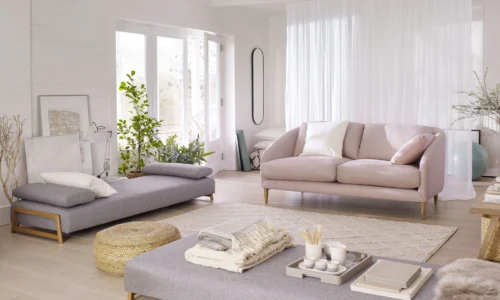Furniture shopping can be an exciting yet daunting task, especially when you’re setting up a new home or giving your current space a makeover.
With so many options, styles, and price ranges available, it’s easy to fall prey to common myths and misconceptions about furniture shopping.
In this comprehensive guide, we aim to bust those myths and provide you with the knowledge you need to make informed decisions while furnishing your home.
Myth #1 ─ High Price Equals High Quality
One of the most prevalent myths about furniture shopping is that you must spend a fortune to get high-quality furniture. While it’s true that premium brands often come with premium price tags, the relationship between price and quality is not always straightforward.
Quality can vary significantly across different price ranges. Great deals on furniture can be found online.
Some budget-friendly options may surprise you with their durability and craftsmanship, while some expensive pieces might not live up to their price tag. The key is to research and assess the materials, construction, and reviews rather than relying solely on price.
When shopping for furniture, prioritize the following aspects to determine quality:
- Materials ─ Look for furniture made from solid wood, high-quality upholstery fabric, and durable finishes. These materials are more likely to stand the test of time.
- Construction ─ Check for sturdy joinery, such as dovetail or mortise-and-tenon joints in case of wooden furniture. Well-constructed furniture tends to last longer.
- Reviews ─ Don’t hesitate to read customer reviews and seek feedback from people who own similar pieces. Their experiences can offer valuable insights into a product’s quality and longevity.
- Warranty ─ A good warranty can be an indicator of a manufacturer’s confidence in their product’s quality. Pay attention to the warranty terms before making a purchase.
Myth #2 ─ Matching Furniture Sets are a Must

Many people believe that all furniture pieces in a room must match perfectly. While coordinating furniture can create a cohesive look, it’s not a strict rule you must follow. In fact, mixing styles and colors can result in a more interesting and personalized space.
Here are some tips for successfully mixing furniture styles:
- Choose a dominant style ─ Start by selecting a dominant style or theme for your space. It could be modern, rustic, vintage, or eclectic. This will serve as a foundation for your design.
- Create balance ─ Balance is key when mixing styles. Pair contrasting pieces, such as a sleek modern sofa with a vintage coffee table, to create visual interest.
- Coordinate colors ─ Use a cohesive color palette to tie different pieces together. This can be achieved through accessories like throw pillows, rugs, and artwork.
- Consider proportions ─ Pay attention to the size and scale of your furniture. Ensure that the pieces harmonize in terms of proportion within the room.
- Experiment ─ Don’t be afraid to experiment with mixing styles. Sometimes, unexpected combinations can result in stunning and unique interiors.
Myth #3 ─ Showroom Displays Represent Real-Life Comfort
When shopping for furniture in a showroom, it’s easy to get swayed by the visual appeal and comfort of display pieces. However, what you see and feel in the store may not always reflect the long-term comfort and functionality of the furniture in your home.
Here’s why showroom comfort can be deceptive:
- Limited use ─ Showroom furniture is typically used for display purposes and may not have experienced the wear and tear of daily life. Comfort and durability can differ when a piece is put to practical use.
- Placement ─ Furniture placement in a showroom may not mimic how it will fit in your home. The layout, lighting, and surroundings can affect your perception of comfort.
- Upholstery and cushions ─ The quality of upholstery and cushions can impact comfort significantly. Pay attention to the materials used and ask about options for customization.
To make an informed decision, consider the following:
- Test it ─ If possible, test the furniture in the showroom by sitting on it or reclining if it’s a sofa or chair. Pay attention to how it feels over time, not just in the moment.
- Read reviews ─ Look for reviews from customers who have purchased the same furniture. Their feedback can give you a better idea of long-term comfort and quality.
- Ask about materials ─ Inquire about the type of cushion filling, upholstery fabric, and frame construction. Higher-quality materials often result in more comfortable and durable furniture.
Myth #4 ─ Online Shopping is Risky
In the past, many people were skeptical about buying furniture online due to concerns about quality, delivery, and returns. However, online furniture shopping has come a long way, and it offers several advantages.
Here’s why online shopping is a viable option:
- Wide selection ─ Online retailers offer a vast selection of furniture styles, sizes, and price ranges, allowing you to find precisely what you’re looking for.
- Convenience ─ You can shop for furniture from the comfort of your home, eliminating the need to visit multiple stores in person.
- Reviews and ratings ─ Online platforms feature customer reviews and ratings that can help you gauge the quality and satisfaction level of previous buyers.
- Price comparisons ─ You can easily compare prices and features across different websites to find the best deals.
- Delivery options ─ Most online retailers offer various delivery options, including white-glove delivery services that assemble and set up your furniture.
While online shopping offers numerous benefits, it’s essential to take precautions:
- Check return policies ─ Understand the return and exchange policies of the online retailer in case the furniture doesn’t meet your expectations.
- Measure your space ─ Be precise with your measurements to ensure the furniture fits your space correctly.
- Read descriptions carefully ─ Pay attention to product descriptions, materials, and dimensions to avoid surprises upon delivery.
Myth #5 ─ Furniture Assembly is Always Easy

Some people assume that all furniture, especially flat-pack or ready-to-assemble pieces, is easy to put together. However, the ease of assembly can vary significantly depending on the manufacturer, design, and your own DIY skills.
Here’s what you need to know about furniture assembly:
- Follow instructions ─ Always read and follow the assembly instructions provided with the furniture. Skipping steps or not using the right tools can lead to frustration.
- Tools required ─ Check whether you’ll need any special tools for assembly. Some furniture may require more than just a basic screwdriver.
- Skill level ─ Consider your own DIY skills and whether you’re comfortable with assembly. If not, you may want to hire professional assembly services.
- Time investment ─ Some pieces can take several hours to assemble, so plan accordingly.
- Quality matters ─ Well-designed furniture tends to have more straightforward assembly processes. Poorly designed or low-quality pieces may come with more challenges.
If you’re uncertain about assembly, don’t hesitate to seek professional help. Many furniture stores offer assembly services for a fee, ensuring your furniture is put together correctly and safely.
Myth #6 ─ Trendy Furniture is Timeless
It’s tempting to invest in trendy furniture pieces to keep your home looking current and stylish. While incorporating some trendy elements can add flair to your decor, it’s essential to strike a balance between trendy and timeless pieces.
Here’s why trendy furniture can be a double-edged sword:
- Short lifespan ─ Trendy furniture is often in vogue for a limited time, which means it can quickly look outdated.
- Expense ─ Constantly replacing trendy pieces to keep up with the latest fads can be costly in the long run.
- Personal style ─ Your home should reflect your personal style and not just the current trends. Mixing timeless pieces with a few trendy accents can create a more balanced and lasting aesthetic.
When shopping for furniture, consider these tips:
- Invest in timeless basics ─ Start with timeless foundational pieces like sofas, dining tables, and beds. These items are less likely to go out of style.
- Add trendy accents ─ Incorporate trendy elements through accessories, such as throw pillows, rugs, and artwork. These can be easily swapped out as trends change.
- Personalize your space ─ Make your home uniquely yours by adding personal touches that reflect your interests, hobbies, and memories.
Myth #7 ─ Buying Used Furniture is Risky
Buying used furniture is often perceived as a risky endeavor due to concerns about quality, cleanliness, and wear and tear. However, when approached wisely, buying used furniture can be an excellent way to find unique, high-quality pieces while saving money and reducing environmental impact.
Here’s how to make buying used furniture a success:
- Inspect thoroughly ─ When buying used furniture, carefully inspect it for any signs of damage, wear, or pests. Don’t be afraid to ask the seller for additional photos or details.
- Research sellers ─ Buy from reputable sources such as thrift stores, antique shops, or online marketplaces with good customer reviews.
- Ask questions ─ Inquire about the history of the piece, including its age, previous owners, and maintenance.
- Negotiate price ─ Don’t hesitate to negotiate the price, especially if you notice any defects or flaws.
- Consider refinishing ─ With some DIY skills or by hiring a professional, you can refinish or reupholster used furniture to give it a fresh and personalized look.
Remember that used furniture can come with character and charm that new pieces may lack. It’s also an eco-friendly choice that reduces waste and supports sustainable living.
Myth #8 ─ Furniture Shopping Should Be Done Quickly

Furniture shopping is a significant investment both in terms of money and the impact it has on your daily life and home aesthetics. Rushing through the process can lead to regrettable choices. Instead, take your time to make well-informed decisions.
Here’s why patience matters:
- Decision-making ─ Rushed decisions can result in furniture that doesn’t meet your needs or fit your space.
- Price comparisons ─ Patience allows you to compare prices and take advantage of sales, discounts, and promotions.
- Design planning ─ Give yourself time to plan your space and consider how each piece of furniture fits into the overall design.
- Quality assessment ─ Take the time to research, read reviews, and visit showrooms or stores to physically inspect the furniture.
- Customization ─ If you’re considering custom furniture, give yourself ample time to discuss options with manufacturers and make design choices.
Remember that your home is a long-term investment, and furnishing it should be approached with care and consideration.




